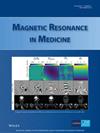Dynamic glucose enhanced imaging using direct water saturation
Abstract
Purpose
Dynamic glucose enhanced (DGE) MRI studies employ CEST or spin lock (CESL) to study glucose uptake. Currently, these methods are hampered by low effect size and sensitivity to motion. To overcome this, we propose to utilize exchange-based linewidth (LW) broadening of the direct water saturation (DS) curve of the water saturation spectrum (Z-spectrum) during and after glucose infusion (DS-DGE MRI).
Methods
To estimate the glucose-infusion-induced LW changes (ΔLW), Bloch-McConnell simulations were performed for normoglycemia and hyperglycemia in blood, gray matter (GM), white matter (WM), CSF, and malignant tumor tissue. Whole-brain DS-DGE imaging was implemented at 3 T using dynamic Z-spectral acquisitions (1.2 s per offset frequency, 38 s per spectrum) and assessed on four brain tumor patients using infusion of 35 g of D-glucose. To assess ΔLW, a deep learning-based Lorentzian fitting approach was used on voxel-based DS spectra acquired before, during, and post-infusion. Area-under-the-curve (AUC) images, obtained from the dynamic ΔLW time curves, were compared qualitatively to perfusion-weighted imaging parametric maps.
Results
In simulations, ΔLW was 1.3%, 0.30%, 0.29/0.34%, 7.5%, and 13% in arterial blood, venous blood, GM/WM, malignant tumor tissue, and CSF, respectively. In vivo, ΔLW was approximately 1% in GM/WM, 5% to 20% for different tumor types, and 40% in CSF. The resulting DS-DGE AUC maps clearly outlined lesion areas.
Conclusions
DS-DGE MRI is highly promising for assessing D-glucose uptake. Initial results in brain tumor patients show high-quality AUC maps of glucose-induced line broadening and DGE-based lesion enhancement similar and/or complementary to perfusion-weighted imaging.


 求助内容:
求助内容: 应助结果提醒方式:
应助结果提醒方式:


